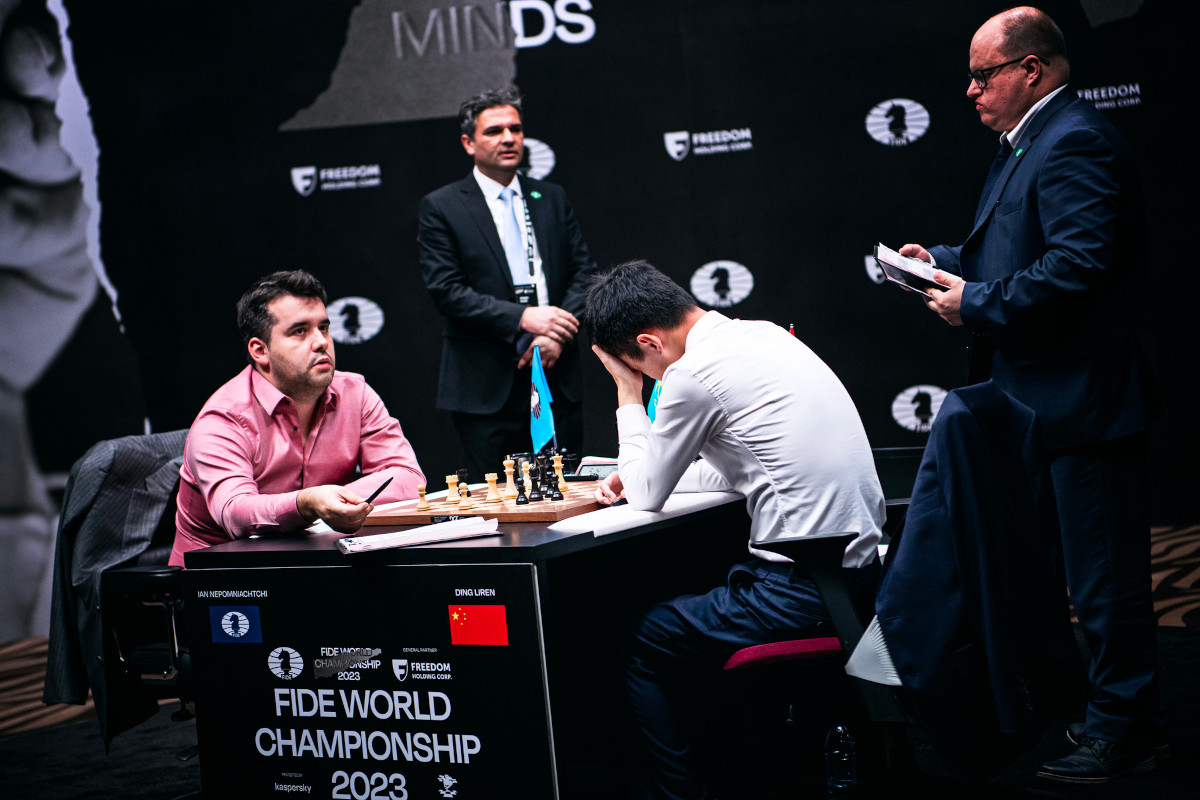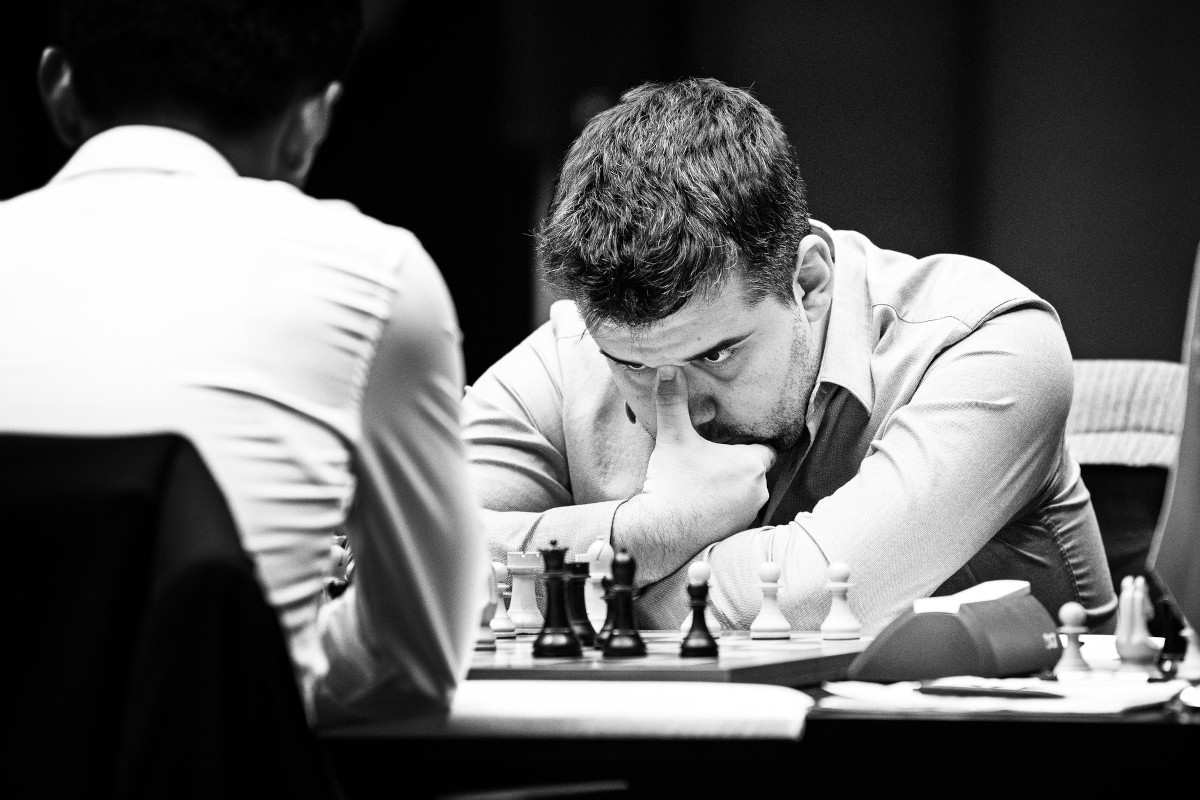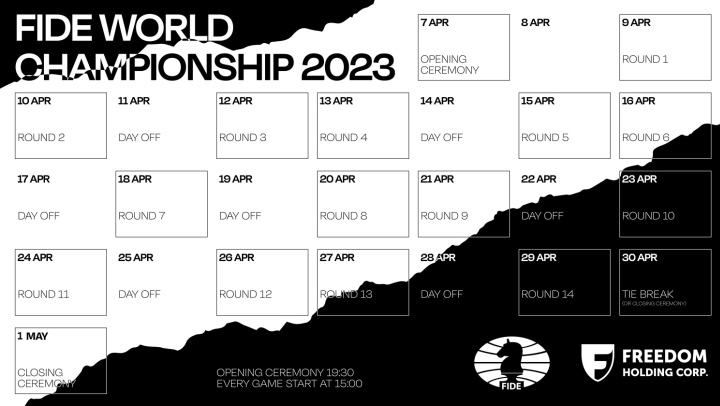


Find expert commentary — video and game annotations — by well-known coach and author IM Robert Ris at the end of the article.
Ding Liren’s 4.h3 in game 2 of the World Championship match was not the last — nor the biggest — surprise he had in store. In game 7, the shocker came as early as on the first move, as Ding decided to play the French Defence in an unprecedented decision for 21st century world-title contests. Ian Nepomniachtchi, who had similarly surprised the chess world by playing the French in the Candidates, chose not to enter the system’s sharpest lines, but that did not prevent the game from becoming a double-edged affair.
Peter Heine Nielsen referred to a 1959 game between Bobby Fischer and Mikhail Tal (a Sicilian, which was not a Caro-Kann) as he quipped on Twitter:
Tal would have put the pawn on e5, kept it in his hand, smiled, and put it back on e6.
Once again the influence of Richard Rapport, Ding’s second, came to the fore. Smiling despite the painful loss, Ding explained in the post-game press conference:
I told Richard that I was going to play the French Defence. But it was half-joke, half-serious. He took me seriously and told me that I can try this to surprise my opponent.
Rapport is known for playing offbeat systems, and he often employs the French with black. In this case, his advice turned out to be right, as Nepo shied away from entering the most trying lines, thus losing a chance to showcase his splendid preparation with the white pieces. It was not the opening what went wrong for Ding, but his handling of the clock.
Ding Liren paused for quite a bit before deciding to play the French Defence today against Ian Nepomniachtchi's 1.e4. The Russian himself is a specialist on this opening. pic.twitter.com/kIo9e5iAxc
— Olimpiu Di Luppi (@olimpiuurcan) April 18, 2023
As the game progressed, Ding continued to look for the most precise continuations, perhaps noticing that this was a great chance to take the lead given his opponent’s cautious approach. The Chinese star eventually gained the initiative, correctly assessing that he could give up an exchange for the bishop pair in a very dynamic position. But his clock kept ticking down, while Nepo, true to his nature, continued to play confidently despite the exigencies of the situation.
Ding spent almost 5 minutes on move 32, and found himself with less than a minute (with no increment) to make eight moves. It was distressing for spectators to see him freeze before making a decision with so little time left on his clock. Somewhat expectedly, he blundered in the very next move.
Nepo had more than enough time to find the refutation, as he went on to win the game four moves later. Commentator Irina Krush described the game as “heartbreaking”, while Erwin l’Ami was one of many pundits who shared that sentiment on Twitter.
Painful to watch, to be honest. Total meltdown. #NepoDing
— Erwin l'Ami (@erwinlami) April 18, 2023
Time-trouble meltdown notwithstanding, credit should be given to Nepomniachtchi for keeping a cool head throughout the game. His choice to play it safe in the opening and his well-known decisiveness allowed him to reach the critical stage of the game with a clear advantage on the clock — a crucial factor in a game with no increments before the first time control. He later explained:
The whole game was extremely sharp and extremely tense. There were a lot of sharp lines, but I couldn’t figure out what to do, so I went to this position where I was slightly worse.
Nepo’s pragmatic approach gained him a lead on the scoreboard for a third time in the match. Remarkably, this was the fourth consecutive decisive game that sees the player with the white pieces winning in Astana. Will the players surpass Tal v Botvinnik from 1961? Douglas Griffin shared on Twitter:
Four consecutive decisive games in #NepoDing. Most in a World Championship since the Tal-Botvinnik return match in 1961, which featured seven(!) (games 7-13, inclusive).
— Douglas Griffin (@dgriffinchess) April 18, 2023
Following a rest day, games 8 and 9 will take place on Thursday and Friday.

Ian Nepomniachtchi took his chance to regain the lead in the riveting confrontation | Photo: FIDE / Stev Bonhage
While it has become commonplace to ridicule the London System and the French Defence on social media — the two openings Ding played in games 6 (which he won) and 7 — the likes of Vishy Anand and Paco Vallejo have been enjoying the show. Right after Tuesday’s game started, Vallejo shared:
Brilliant moves from both sides, tight score, diverse openings, and even some action for the French Defense lovers, what a match! #NepoDing
— GMVallejo (@Chessidharta) April 18, 2023
Ding knew that he needed to make concessions in this system, as he agreed to play with an inferior queenside pawn structure while dealing with White’s threats on the kingside. In exchange, he managed to activate his pieces.
Black’s next two moves were praised by the commentators (and later by Nepomniachtchi himself): 20...Nh5 21.f4 Bd6, and Ding was playing for more than equalization.
By entering this line, Black was prepared to give up an exchange, as Ding blitzed out his moves in the following sequence: 22.c3 Nxf4 23.Bxf4 Rxf4 24.Rxf4 Bxe5 25.Rh4
Black’s bishops and queen look menacing, while White’s battery on the h-file is not as effective, given the fact that the dark-squared bishop is now unopposed and plays a double role from e5.
Understandably, Nepo played Bd3-e4 on the next move, offering a bishop trade, which Ding accepted (to Anish Giri’s bewilderment). Ding still had the upper hand, though, until disaster struck on moves 32-33.
Extreme precision is needed here to keep Black’s advantage, and Ding was surely considering 32...Be5 (the best alternative) as he saw his time dangerously running out. His 32...Rd2 results in a 0.00 evaluation by the engines, but White still needs to be careful to keep everything under control.
Nepo, who still had a reasonable amount of time on the clock, replied by 33.Re2. Ding then erred with 33...Rd3 (33...Rd5 was the way to go), and the Russian calmly calculated that his king is safe after 34.Qxc5 Rd1+ 35.Kg2 Qd3 36.Rf2
White has not only grabbed the c-pawn, but is also counterattacking along the f-file. Ding resigned after 36...Kg7 37.Rcf4 Qxc3. Heartbreaking, indeed.

Three seconds on the clock | Photo: FIDE / Stev Bonhage

| Advertising |